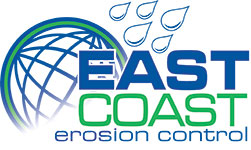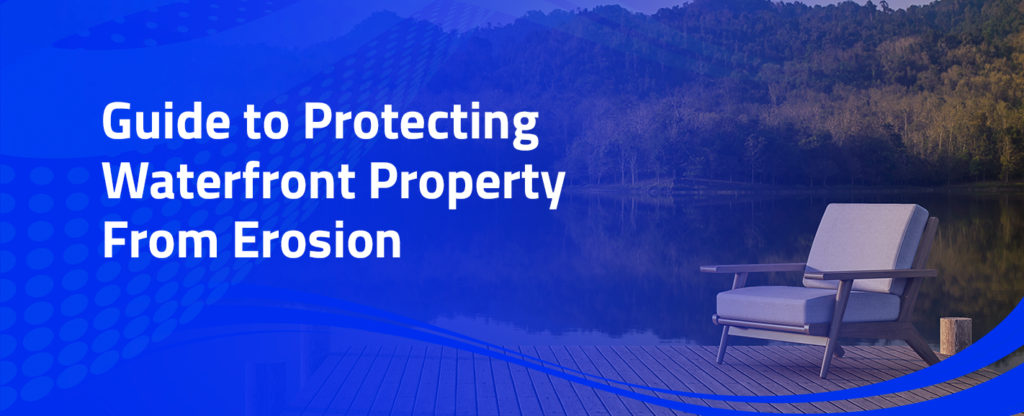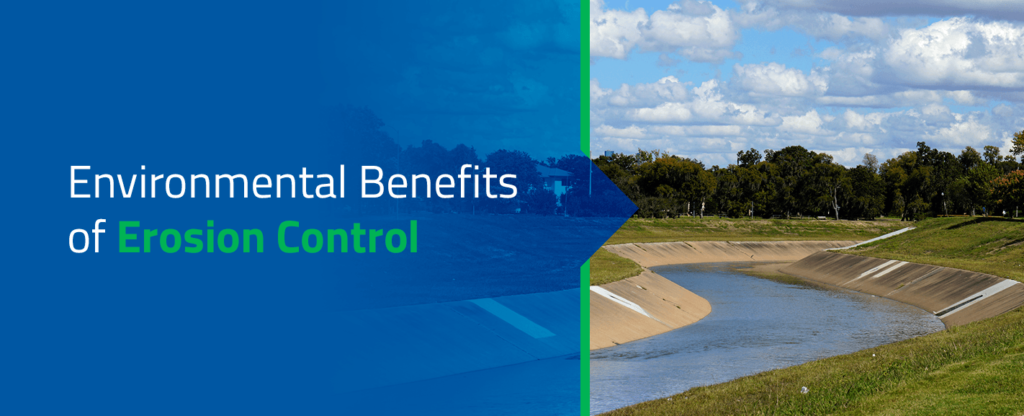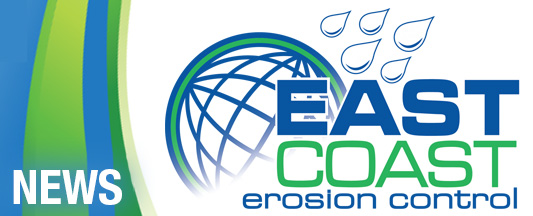What Is an Erosion Control Blanket?
SHARE
Erosion is a naturally occurring issue, as it can be the result of rainfall, wind, severe weather and other climate-based changes. But in many industries, such as construction and land reclamation, altering the existing characteristics of the land and removing vegetation and topsoil can increase the effects of erosion.
Erosion control blankets provide a cost-effective and straightforward solution. By covering areas of open land with these mats, you can help prevent soil shifting and promote new plant growth before, during and after your project. This guide will cover the general erosion control blanket definition, how erosion control blankets work and what kinds of purposes they fulfill, among other details.
Erosion Blankets Overview

Erosion can be a significant issue for communities, interrupting natural processes and changing the landscape. Soil erosion occurs in situations where outside forces, such as weather and runoff, cause soil particles to detach, move from their original location and deposit in a new area. There are many different varieties of erosion based on the surrounding landscape and patterns, such as sheet, gully, stream bank and bed and wind erosion.
Erosion control blankets are also called erosion control mats depending on their specific purposes and materials. They work to fight soil erosion of several varieties and prevent any related damages while providing added soil stability. With proper placement, the mats will help keep sediment and topsoil from shifting until vegetation takes root, which naturally fights erosion.
These blankets typically come rolled like carpets, allowing developers to place and unroll them in their desired locations. Rolled Erosion Control Products (RECPs) consist of organic or synthetic materials or a combination of both. Some of the most common materials include coconut fiber, wood excelsior, agricultural wheat straw, polypropylene blends concrete blends and other synthetic fibers.
Types of Erosion Control Blankets
When it comes to erosion control, the type of mat you need depends on your worksite and the conditions of the landscape. There are semi-permanent types made from a higher percentage of natural material, which will degrade over time. You can also find permanent models, made with a higher density of synthetics, which are excellent for longer-term projects and applications. Blankets contain different thicknesses and blends of fibers.
Below are a few different types of erosion control blankets:
1. Photodegradable Erosion Control Blankets
Photodegradable erosion control blankets typically have netting made from materials like plastic. The plastic contains UV stabilizers designed to stop functioning after a specific amount of time. After that happens, those parts of the netting break down under exposure to sunlight. The parts of the netting that are not exposed to sunlight, though, may take much longer to degrade.
2. Biodegradable Erosion Control Blankets
Biodegradable erosion control blankets typically contain natural fibers rather than plastics. The fibers break down into the natural environment, so these blankets are an excellent choice for projects where minimal disruption to the natural environment is a high priority. Depending on their composition, biodegradable erosion control blankets may break down in a matter of months, or the process may take a few years.
3. Permanent Erosion Control Blankets
Permanent erosion control blankets provide the longest-term solution available. While the matrix may decompose, the blankets are designed not to break down at all. Two common types of permanent erosion control blankets are Turf Reinforcement Mats (TRMs) and High-Performance Turf Reinforcement Mats (HPTRMs).
- Turf reinforcement mats (TRMs): TRMs typically contain a blend of synthetic fibers, nets, filaments and wire mesh bound together to form a durable blanket. TRMs may also have supplemental degradable elements, including straw, coconut fibers, wood and other forms of natural fibers to help provide the best environment for immediate soil protection and encouraging new vegetation growth. Typically, companies use TRMs for applications involving water control, such as in channels or ditches, on the sides of steep slopes, around the banks of streams, on shorelines and any other areas where there are strong erosive forces. These mats help protect the landscape, reinforce plant life and stabilize the soil.
- High-performance turf reinforcement mats (HPTRMs): HPTRMs are TRMs that can take on more heavy-duty jobs. They have a higher tensile strength and improved reinforcement for stabilizing and protecting topsoil. They can handle the most intensive erosion protection jobs in areas where there is little to no natural vegetation or where gravity, hurricanes or wave impacts increase the effects of runoff. Some of the environments where HPTRMs perform the best include steep slopes, structural backfills, high-flow water channels, pipe inlets and outlets, maintenance access areas, utility cuts, streams, banks, coasts, levees and stormwater systems.
Erosion Control Blanket Design
While erosion control blankets can come in many different materials, they all have a similar general design.
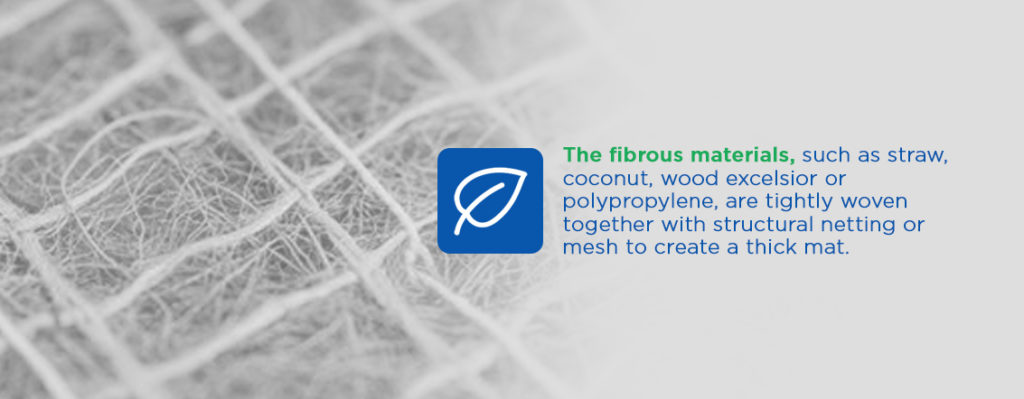
The matrix made of fibrous materials, such as straw, coconut, wood excelsior or polypropylene, are tightly woven together with structural netting or mesh to create a thick mat. Depending on the intended use and construction, different models of blankets have varying levels of weave and matrix density, durability and longevity.
In general, all erosion control blankets need to have a high level of porosity to allow for airflow and promote moisture retention and plant growth. However, they should still be thick and have a strong structure to protect and stabilize the topsoil they cover.
Blankets may have one, two or three nets madeeither of polypropylene or jute. There are also four varieties of netting strength, divided into categories:
- Ultra Short-Term: The net backing on ultra short-term blankets decomposes the fastest. It should begin to break down about one month after installation and be 80% decomposed after three months of use. These may also be called accelerated blankets.
- Short-Term: The netting on blankets in short-term blankets remains functional longer than ultra short-term blankets, but they’ll still decompose at a reasonable rate. They have the appropriate amount of UV stabilization to function through a regular growing season but break down entirely by the end of the period.
- Extended-Term: Netting on extended-term erosion blankets typically have the durability to maintain soil integrity for two years. These blankets are composed of processed slow degrading natural or polymer fibers to extend their functional longevity longer than short-term blankets.
- Long-Term: The net backing on long-term erosion blankets has the most extended lifespan. It has better UV stabilization than the lower levels, allowing it to remain active for up to two to three years before fully decomposing.
In addition to these categories, there are also the permanent erosion control blankets that don’t decompose and provide the longest-term solution available. Most mats have netting on both sides, in which case the fiber materials are contained between the netting layers. The double-sided design ensures the fibers remain securely attached and don’t move away from the original placement site.
Erosion Control Blanket Purpose
Erosion is a natural occurrence. Depending on the area and climate you’re working in, you can be up against heavy rainfall and runoff washing away the topsoil, high-speed winds blowing away the dry dirt, gravity contributing to shifting soil on steep slopes and more. These events can be dangerous for workers, inhibit progress on your project, and prevent vegetation from providing natural erosion control. They can also carry pollutants and contaminants, endanger water resources and damage man-made structures and infrastructure.
The primary purpose of erosion control blankets is to keep soil from shifting or moving. They help stabilize soil particles and sediments, holding them in place to prevent sliding due to water, wind or other natural causes. By holding the earth still, these blankets also create an environment where new seed can take root. They keep the seed protected and covered and provide a stable area for it to begin growing while also allowing the air and water it needs.
RECPs are essential for human-made erosion risks. For example, in transportation construction, developers often have to flatten out sloped areas or carve new embankments. Placing erosion control blankets on loosened, exposed soil can prevent destructive mudslides and hold the earth in place until plants can take root and naturally protect the area. The same concept applies to mine and oil well reclamation projects.
Benefits of Erosion Control Blankets
Beyond protecting the integrity of your landscaping, erosion control blankets have significant benefits, including:
- Cost-efficiency: RECPs are a cost-effective method of preventing soil shift. They have a relatively simple design, consisting of layers of woven or otherwise bound natural and synthetic fibers. They’re a more effective and lower-cost alternative to other methods of erosion and can help your teams save time and money on projects. By preventing soil movement, you can avoid project setbacks related to erosion.
- Versatility: While the varieties of erosion control blankets all work towards the same goal, they’re also surprisingly versatile. They’re essential to many different industries and types of projects, either by regulation or general need.
- Ease of use: Overall, RECPs are easy to install and maintain. You can apply them to a variety of terrains by rolling them out, laying as many side-by-side as you need to cover the desired area. They’re also transportable to locations where heavy machinery may not be able to reach safely, such as on the banks of waterways.
- Decomposition: Since many varieties of RECPs are made of natural materials, they break down over time. This feature means there’s no need to retrieve the mats and that they will contribute to the revegetation and soil stability past their intended use period.
Permits and Requirements
Erosion control regulations and permit requirements exist in many industries, especially transportation, construction and well or mine site reclamation. Before laying down erosion control blankets, you do need to fulfill the correct permit applications and requirements.
However, the specifics of applications and requirements vary from state to state, so it’s essential to check the regulations in your location. To find out more about the Federal Highway Administration (FHWA) requirements for construction, you can check their erosion and sediment control listings. You can also find the Department of Transportation (DOT) specifications by state, which will show you what permits and prerequisites you need.
Some businesses, such as those that work on transportation infrastructure, may have to choose from a prequalified list of products. In those cases, the state DOT may have a list of acceptable companies and products for erosion control and management.
Industries That Use Erosion Control Blankets
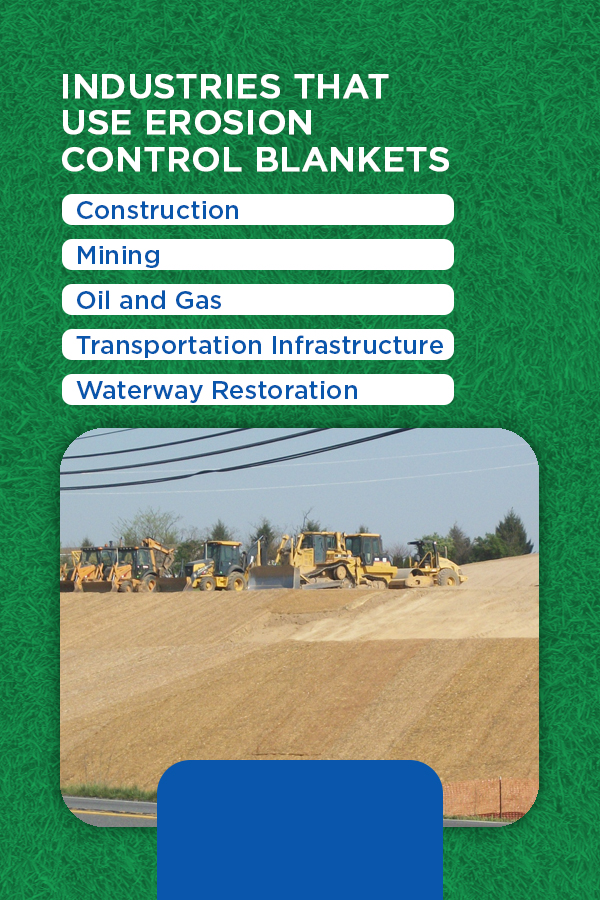
Erosion control is a process that many industries use to protect newly built structures, prevent soil displacement, rebuild banks, assist in landscaping, control water flow and promote the establishment of vegetation. In some cases, industry standards and national laws require them.
Low Impact Development (LID) is also a key objective in many industries. LID focuses on systems and practices that mimic natural development and help protect water quality and preserve habitats. It uses runoff prevention strategies and mitigation to manage rainfall at the source and minimize its harmful effects. As part of their LID strategies, industries can use erosion control blankets to lower their projects’ impact on the surrounding environment.
Among the various commercial uses, here are some of the applications for erosion control blankets:
Construction
Both residential and commercial construction require erosion control for specific projects. The landscaping and building that go into creating new homes, stores and office buildings change the erosive landscape of the surrounding area, as well as the water quality and various habitats. As construction companies move soil and uproot the natural vegetation, they may create regions more prone to soil erosion.
To help prevent soil shifting and promote the growth of new vegetation, these companies can use erosion control blankets. They also help with establishing landscaping, restoring the soil, managing storm runoff and creating better drainage leading away from main structures.
Mining
Coal mine sites are heavily occupied by loose sediments and soil, meaning sediment and erosion control is essential for successful coal mine reclamation. Individual states have regulations regarding the specifics for reclamation, but sediment control is required under the overarching Surface Mining Control and Reclamation Act (SMCRA) and Clean Water Act (CWA). Local authorities may also take into consideration doing what is best for local wildlife, environment and water sources when evaluating erosion control plans.
Once reclamation teams create the necessary sediment ponds, they must focus on managing runoff with erosion control blankets and wattles. The application of RECPs assists in reinforcing soil stability, holding sediment in place and encouraging the growth of new vegetation on bank structures.
Oil and Gas
The process of extracting oil and gas from beneath the earth’s surface requires a significant amount of soil disturbance. Between the reclamation of inactive well sites, pipeline excavation and building and drilling site operation, oil and gas industries can do a lot of damage to natural soil, vegetation and natural water flow processes. Observing proper erosion control measures and addressing issues as you relocate and pack topsoil is essential.
On top of regulating gas extraction operations, states also require reclamation efforts for inactive wells and extraction sites, including restoration of roads, loosening packed topsoil, protection of wetlands and natural habitats and other initiatives. RECPs can significantly help prevent soil erosion during drilling and installation processes and promote landscape protection during restoration.
Transportation Infrastructure
To create new roads, bridges and other transportation structures, developers and construction teams have to clear areas of topsoil, compact fill material and shape the earth through digging and layering. With the addition of construction, these processes can affect the flow of rainfall and water, leading to soil erosion that prevents growth and interferes with the infrastructure. State DOTs require erosion control to help minimize vehicular dangers, protect the natural landscape and maintain the integrity of the infrastructure.
RECPs and other erosion control products typically have to comply with set standards, including those of the American Association of State Highway and Transportation Officials (AASHTO), the American Society for Testing and Materials (ASTM) and the National Transportation Product Evaluation Program (NTPEP). With proper placement, erosion control blankets help companies with state DOT regulation compliance as well as soil retention and water management.
Waterway Restoration
Over time, streams and rivers can become subject to harmful erosion patterns. From ice formations to floods and rainfall, weather conditions can erode banks, undercut terrain and loosen major tree roots. Along with natural causes, dam installation, reconstruction and removal can have a significantly negative effect. Waterway restoration teams can use erosion control tactics to their advantage.
Erosion control blankets are excellent for repopulating natural vegetation and building up banks, especially in areas with sensitive ecosystems. They’re also helpful for occasions where using heavy machinery would be unsafe for workers or unfeasible due to the state of the banks, as well as in remote locations.
Provide Reliable Erosion Control With East Coast Erosion
When it comes to erosion control methods, you need to ensure you have a reliable product at the ready. At East Coast Erosion, we understand the importance of quality. Our RECPs meet or exceed industry standards, including those of state DOTs and the Army Corps of Engineers. We offer a wide range of erosion control blankets, from accelerated to permanent solutions, made from a variety of materials, including straw, excelsior, coir and polypropylene.
Ensure your site controls erosion issues with East Coast Erosion — browse our RECP blankets for more information.
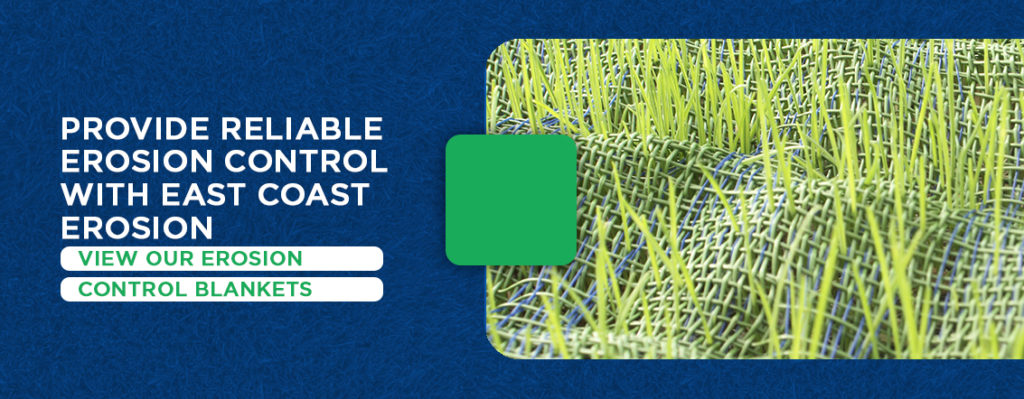

Further Reading
Guide to Protecting Waterfront Property From Erosion
When shoreline erosion occurs, significant problems arise for the environment and surrounding waterfront properties. Your…
Environmental Benefits of Erosion Control
In many applications like construction, vegetation removal leaves the landscape vulnerable to erosion, which washes…
Essential Today: Erosion Control Blanket Manufacturing
Why Are We Essential Erosion control products are designed to protect drinking water nationwide. Water…
